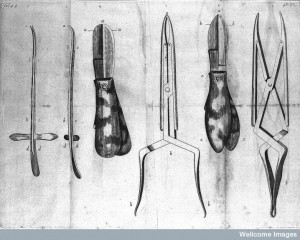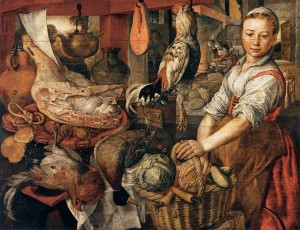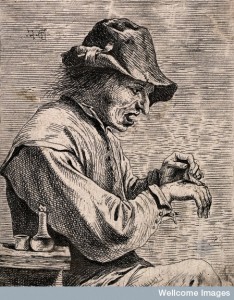
One of the diseases, found particularly in men, which I come across frequently in this research is The Stone or Gravel, in the kidneys or in the bladder. These stones were thought to be caused by excessive build-up of humours within the urine, in hot bodies these humours would ‘bake’ or harden into troublesome stones that would obstruct urination or tear the bladder causing bleeding and pain. The Navy surgeon John Moyle wrote of the pain suffered by those who were struck down with this disease while at sea, and so couldn’t expect much relief: ‘SOmetimes Men happen to be cruelly tormented with this disease at Sea, and although they do not expect you perfectly to cure it, yet they would be glad of a little ease, and it would make any man pity them to see them so excruciated.’1

Credit: Wellcome Library, London.
Nearly every medical and surgical text in the seventeenth century discussed this particular disease and outlined the many methods of treatment. Finding an effective treatment was very important, as if the stones could not be passed out when urinating or dissolved within the body the only option left was to undergo Lithotomy, ‘cutting for the stone’. This was a grizzly and dangerous procedure that involved cutting either the penis or another part of the genital region to allow for the removal of stones with a variety of instruments like the crochet and forceps.
The dangers of this operation ranged from damage to the urinary system to death. Indeed having being cut for the stone Samuel Pepys, the famous diarist, not only kept the great stone as a souvenir but marked the anniversary of the procedure and gave thanks for having survived. Pepys had good reason to celebrate, the four men who subsequently underwent the procedure with his surgeon all died.2 Physicians were especially inclined to note the dangers of the surgical operation and warned that if not done correctly the patient would be left with further, or the very same, problems:
‘If the Stone in the Bladder be very big, there is little hopes of dissolving of it, wherefore if the Patient (being in continual pain) be willing to submit to Lithotomy; I advise them to make choice of an experienc’d Artist; lest by Precipitancy the Operatour neglect to cleanse the Bladder, after the Extraction of the Stone; by the neglect of which, many have generated the Stone again, and have been forced to endure that dreadfull operation the second, and sometimes the third time, under which many have died, and others who recovered have never held their Urine.’3
With the dangers of the surgical method of treatment so apparent it was thus important for medical practitioners to find other remedies and cures that would dissolve the stones and so remove the necessity of surgery. Men were perhaps quick to buy remedies that would save them from this disorder. Many quacks (unqualified or unregistered physicians) sought to jump on this opportunity to make money and offered remedies that promised to do just this, much to the disgust of qualified physicians and surgeons: Joseph De la Charrier lamented that
‘Here it is where Mountebanks triumph, who, by their Impostures, endeavour to persuade People that they have infallible Secrets to dissolve the Stone in the Reins and Bladder; these sweet hopes flatter the minds of those who are troubled with it’.4

The need for these remedies leads us to the stone, knife and radish of the title and a small medical treatise called the The Poore-mans Plaster-box. Furnished with diverse Excellent Remedies for sudden Mischances, and usuall infirmities published in 1634. Having listed several remedies for the stone the author of this text concluded with this story:
A Remedy for the Stone strangely found out.
A certain High Dutchman, being very well skild in cutting for the Stone, was on a time called to an old Gentleman, which was very much troubled with that Infirmity, he having searched him, found the stone to be of such an extraordinary bignesse, that he would not deale with it, a while after this Gentleman dyed, he being acquainted with his friends, desired to open him for to see the stone, in briefe he did, and found is so great, and of such a length, and hardnes, that he woundred thereat, for it was so big that he made a haft for a knife thereof; this knife he being once at supper left on the Table, and the cloath being taken up, the knife was (unwittingly) taken up with it, and so cast on one side with the fragments; next day he missed his knife, and search was made fore it, and it was found in a voyder, amongst scraping and peeces of Raddish rootes: but so strangely altered that he greatly wondered thereat, for through the vertue of the Radish (against that disease) the haft was found wholly to be consumed: which made him ever after, for to use Radish, against that disease. Whether, this be true or not, I will not examine, but this I know. Take a Radish roote and steepe it in white Wine, all night, and give it to drinke, to one that cannot make his. 5
Several things may strike us as odd about this story, none less so than the fact that the surgeon made a piece of cutlery out of the stone removed from the patient! This bizarre story demonstrates to us one of the basic principles of discovering medicines in early modern England – observation; this may be a long story but it shows in detail how the new remedy was initially observed to work. Although very strange to us this story also shows us how early modern medical authors and readers used narratives to help them understand the cures they took. As the author states he wasn’t sure he himself believed the story, but he included it because he believed the remedy worked and so it provided some substantiation to these claims. And so in relating this story the author turns the humble radish, something likely to be available to even the poorest people in society, into the perfect cure for a common and distressing disease!
____
1. John Moyle, Abstractum Chirurgiæ Marinæ. Or, An Abstract of Sea Chirurgery: Designed for the use of such Chirurgeons who desire to serve at Sea, yet are unacquainted with Sea Practice … (London, 1686), p. 87.
2. Lynda Payne, With Words and Knives: Learning Medical Dispassion in Early Modern England (Ashgate: Aldershot, 2007) p.36.
3. Robert Johnson, Praxis Medicinæ Reformata: or the Practice of Physick Reformed. Being an Epitome of the Whole Art … (London, 1700), p. 265.
4. Joseph De la Charrier, A treatise of chirurgical operations after the newest, and most exact method founded on the structure of the parts … (London, 1696), p.107.
5. Anonymous, The Poore-mans Plaster-box. Furnished with diverse Excellent Remedies for sudden Mischances, and usuall infirmities, which happen to Men, Women, and Children in this Age (London, 1634) , p.27
© Copyright Jennifer Evans all rights reserved.





4 thoughts on “The Stone, the Knife, and the Radish: Discovering Medicines”
Comments are closed.